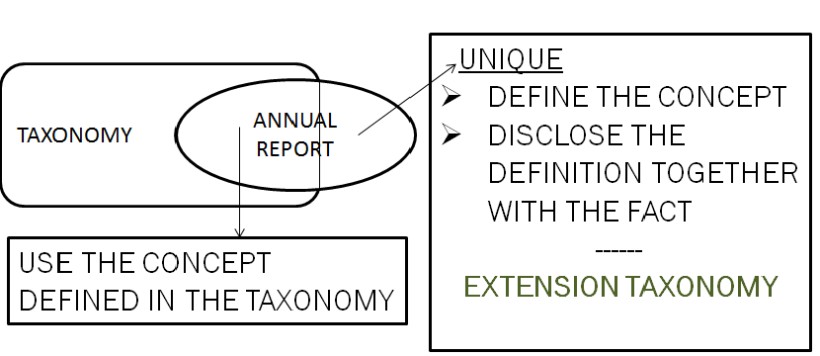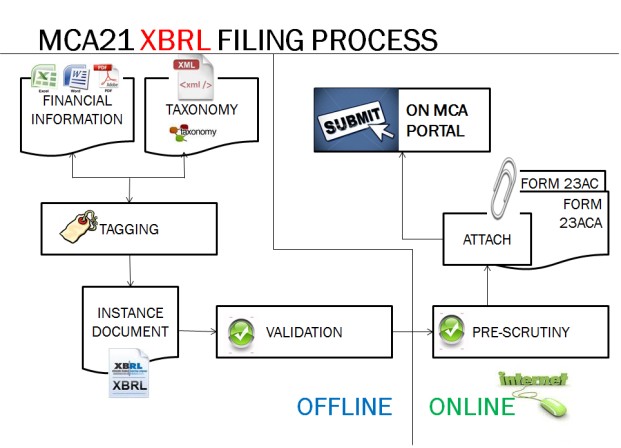(This article has been published by the Guwahati Branch in their Souvenir for the National Conference of ICAI held at Guwahati, Assam on 16-17 December 2011.)
A. Introduction to XBRL
XBRL is the buzz word today in our professional fraternity. Why not, ‘The Companies (Filing of documents and forms in Extensible Business Reporting Language) Rules, 2011’ has mandated filing of annual reports of specified class of companies using XBRL and as always, something new, a jargon probably never heard before, has been thrown at us to comply with.
In the following paragraphs, we try to unravel this mystery and solve the puzzle –answer a few basic questions – Why, What, Who, How and Where – put together these fragments to frame a picture called XBRL.
1. Why we need XBRL?
Every entity, commercial or otherwise, is required to prepare and present one or more financial reports to showcase its activities or operations and its financial standing. However, the Financial Reporting model today involves manual processes and is rather disjointed.
Even in the era of advanced automation and Electronic Data Processing, applications or computer servers seldom interact outside their periphery, because different applications have different data structures and generate reports in closed formats (word, excel or pdf) i.e., to say, the output of one application is not automatically input in another application for further processing. This gives rise to manual extraction and re-entry of data which is laborious, error prone and adds no value.
The users of financial information – regulatory authorities, stakeholders, lenders, etc. have differing requirements. This leads to a disjointed system of financial reporting requiring the preparer to prepare multiple financial reports for different users.
Consequentially, more time & energy is spent on data mining and data gathering and less is spent on data analytics. With XBRL, we intend to reverse this.
2. What is XBRL?
To begin with, XBRL is an abbreviation for eXtensible Business Reporting Language.
XBRL is an Open Standard XML based language for electronic communication of business and financial information and on the Internet.
However, XBRL is a more powerful and flexible version of XML which has been defined specifically to to meet the requirements of Business & Financial information.
Conversion of Financial Information into XBRL involves tagging of Individual elements or item in the financial report (Concepts) for their electronic dissemination.
These concepts are defined in a Taxonomy based on a Common Accounting Framework (say, Indian GAAP, IFRS or US GAAP, etc.). Thus, Taxonomy is basically a Dictionary of financial reporting terms or concepts. Since national jurisdictions have different accounting regulations and accordingly separate Taxonomies are developed for different reporting purposes such as Indian GAAP Commercial & Industrial (C&I), IFRS, Bank Regulatory reporting, etc.
XBRL is an Open Standard and is thus free of all licenses and royalty. It is also software and application independent. However, here lies the catch – basically, the Taxonomy or the Data Standard is free – the tools and applications to convert and / or view the Financial Report are developed by proprietary software vendors and are accordingly subject to a license fee.
XBRL is extensible. Each entity’s business operations have unique aspects of reporting. An EXTENSION TAXONOMY allows a company to create and customize concepts and elements for their particular reporting practices. Extension taxonomies import then build on, or “extend” the core reporting taxonomy.
This characteristic of extensibility of XBRL provides it with the much needed flexibility and adaptability to differing accounting environments. Without extensibility, XBRL would have been a mere standard chart of accounts.

Figure 1 – Explaining the Extension Taxonomy
What XBRL is NOT!
XBRL is neither an Accounting Standard nor a computer program. It is also not a limited chart of accounts or a proprietary information standard or software.
Simply stated, XBRL is a language for transmitting information. It must accurately reflect data reported under different standards and regulations – it does not change them.
3. Who develops XBRL?
The origins of XBRL lie in the proposal of Mr Charles Hoffman, AICPA to use XML (eXtensible Mark-up Language) for electronic reporting of Financial Information.
XBRL is being developed by XBRL International Inc. (XII). XII is a Not for Profit consortium of Regulators, Government Agencies, Accountancy Institutes, Leading Corporates, IT & Financial & Professional Services Companies.
XBRL International Inc. (XII) is a Consortium similar to how the Universal Product Code (UPC) Seal (commonly ‘Bar Code’) was developed… and BAR CODING HAS REVOLUTIONISED PRODUCT DISTRIBUTION. WHAT WILL XBRL DO TO FINANCIAL REPORTING?
Well, we’ll answer this question after we first learn how XBRL works.
4. How XBRL Works?
A Simple Explanation
The idea behind XBRL, eXtensible Business Reporting Language, is simple. Instead of treating financial information as a block of text – as in a standard internet page or a printed document – it provides an identifying tag for each individual item of data. This is computer readable. For example, company net profit has its own unique tag. This enables reporting software to collect relevant data and place it in the appropriate financial reports.
XBRL “Tags” can be thought of as a “Bar Code” system for financial information, allowing financial statements to be read and understood by a computer. XBRL will do for Financial & Business Reporting what Bar Code has done for Product Distribution.
5. Benefits of XBRL
The introduction of XBRL tags enables automated processing of business information by computer software, cutting out laborious and costly processes of manual re-entry and comparison. Computers can ACCESS, EXTRACT AND PROCESS XBRL data “intelligently”: they can recognize the information in a XBRL document, select it, analyze it, store it, exchange it with other computers and present it automatically in a variety of ways for users. XBRL greatly increases the speed of handling of financial data, reduces the chance of error and permits automatic checking of information.
Probably, the best explanation of benefits derived from the use of XBRL lies in the following words of Mr John Connors, Chief Financial Officer, Microsoft – “Through Internet delivery, XBRL will also provide analysts and investors with extensible financial data to make informed decisions about the company. We see XBRL as not only the future standard for publishing, delivery and use of financial information over the Web, but also as a logical business choice.”
6. XBRL – Around the World!
XBRL is growing quickly around the world with increasing participation from individual countries and international organisations. At present, XBRL International is comprised of 23 Established jurisdictions and 3 Provisional jurisdictions which represent countries, regions or international bodies and which focus on the progress of XBRL in their area.
B. XBRL in INDIA.
1. Introduction
XBRL India, a company registered under section 25 of the Companies Act, 1956 is the Indian Jurisdiction of XBRL International Inc. (XII).
The main objective of XBRL India is to promote and encourage the adoption of XBRL in India as the standard for electronic business reporting in India.
XBRL India has overseen the development of the Taxonomy for Indian GAAP Commercial and Industrial and Indian GAAP Banking taxonomy. Separate taxonomies for insurance and power sector are under development.
XBRL Projects in India
RBI has already implemented Capital Adequacy Reporting by Banks as per Basell II norms in XBRL.
MCA has mandated the e-filing of annual reports in XBRL format for specified classes of companies.
SEBI has an under development project – “Super-D” for XBRL filing by all Listed Companies and Mutual Funds in India.
The Central Electricity Regulatory Commission (CERC) is also developing an XBRL based Regulatory Information Management System (RIMS).
2. The MCA21 Mandate
The Ministry of Corporate Affairs (MCA) envisages a two-phase approach for implementation of XBRL based reporting of Company Annual Reports.
In the first phase beginning April 1, 2011, select class of companies noted below are required to file their annual reports using XBRL.
They are:-
a. All Listed Companies & their Indian Subsidiaries
b. Companies with Paid up Capital >= 5 crores
c. Companies with Turnover >= 100 crores
However, Banking, NBFC, Insurance & Power Sector companies are excluded.
In the second phase beginning April 1, 2012 ALL COMPANIES(Including Banking, NBFC, Insurance & Power Sector Companies) are required to file their annual reports using XBRL.
Further, the existing Commercial & Industrial (C&I) Taxonomy to be UPDATED & MAINTAINED to conform to REVISED SCHEDULE VI and new Taxonomy(ies) for Banking, NBFC, Insurance & Power Sector Companies are under development.
(Source: http://xbrl.icai.org/)

Figure 2 – MCA21 XBRL Filing Process
3. Role of Finance Professionals in XBRL Filings.
XBRL provides an exciting opportunity to finance professionals in the following fields:
1. Compliance with the MCA Regulatory environment;
2. Impact assessment of XBRL on Management Information Systems;
3. Designing extension Taxonomies; and
4. Mapping (Tagging) line items in accounts masters with the XBRL Taxonomy.
5. Certification of XBRL Financial Statements
The responsibility of the practitioner in carrying out a certification of XBRL financial statements is to certify that the said XBRL financial statements fairly present, in all material respects, the audited financial statements of the Company from which such XBRL financial statements have been prepared, in accordance with the taxonomy prescribed by MCA.
In this regard, the ICAI has issued a Guidance Note on Certification of XBRL Financial Statements. The said guidance note, inter-alia, entrusts the practitioner to ensure completeness, accuracy, mapping and structure of the XBRL financial statements.
C. Conclusion
Businesses and accountants gain significant benefits through easier preparation, analysis and communication of information. These benefits include cost savings, greater efficiency, and improved accuracy and reliability of information.
XBRL is the emerging global standard of Financial Reporting. XBRL will change the way we communicate with the regulators in the years to come.







 CAclubindia
CAclubindia
